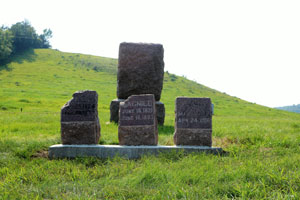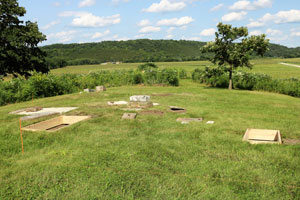It is heartbreaking to see cemeteries that have come into such disrepair that they are hardly even recognizable as a cemetery anymore. And although we feel disheartened when we see these cemeteries falling further and further into remnants of what they once were, what can one person do?
As shown by Don Lukkason of Lanesboro, Minn., one person can do a lot when they set their mind to it and enlist the help of others willing to help achieve an honorable goal.
Around 2015, Lukkason took an interest in the Root River Settlement Burying Ground (Bell-Bjelde Cemetery) on Gaelic Road north of Lanesboro, as he was investigating some of his family ancestry documents at North Prairie Church near Lanesboro.
“In the bottom of a file cabinet was a record book that was labeled Root River Burying Ground (Bell Cemetery), founded by researchers Ted and Wanda Olson of Fremont,” states Lukkason.
As Lukkason has a keen interest in history, he found the cemetery and met the nearby landowners John and Jennifer Horihan, who like to stop and talk to those visiting the cemetery as they may be descendents of someone buried there.
For over 100 years the cemetery has been maintained by the Horihan family. In recent history the cemetery has been taken care of by John and Jennifer Horihan, who live in the original Knud and Anne Knudson (Bell) farm that Charles Horihan purchased in 1912.
Although the Horihan family has maintained the cemetery well over the last 100-plus years by keeping it mowed and trimmed, over time many headstones had fallen to pieces, a condition Lukkason felt needed to be addressed. And so began a several year project that would be spearheaded by Lukkason.
A manuscript of the history of the Bell Cemetery was located by Debra Richardson, Executive Director of the Fillmore County History Center and Museum in Fountain, Minn. Richardson was an invaluable asset to Lukkason throughout the project.
Bell Cemetery is a pioneer cemetery which was officially named Root River Settlement Burying Ground in 1867. Many early settlers are buried in the one-acre cemetery, which was sold by Knud and Anne Knudsen (Bell) to a cemetery association in 1867 for $10.
Both Richardson and Lukkason noted that it is very unusual for a cemetery to have the title of burying ground. “Burying grounds is actually a Yankee term, which is very unusual to have west of the Mississippi,” states Richardson, “especially Norwegians.”
Through their research, Richardson and Lukkason found historical information in Images of America, Lanesboro, Minnesota, Historic Destination by Don Ward and Ted St. Mane, “On the Banks of the Root River” (writings from the estate of Harvey Sathre), and 1882 History of Fillmore County. Included in their research was the fact that this area near Lanesboro, in Carrolton Township, was settled by immigrants from Sogn fylke (state), Aurland (district) and Bjelde gard (farm area) of western Norway.
Upon arrival to America from Norway, they settled in Koshokong, in Dane County, Wis., in the mid-1840s. In 1854 they came to the territory of Minnesota. Knud and Anne Knudsen (Bell), Rognald and Tollev Knudsen (Bell), R Peterson, and Jules and Sille Skari were the first to settle in the area.
In approximately 1856, the area of Carrolton Township which is now Lanesboro was welcoming new settlers with names such as Con Scanlon, Thomas Barrett, Ed and Charles Johnson, John McLaughlin, Lars Christenson and Ed Enright.
For several years, ranging from approximately 1867 to 1920, burials in the Bell Cemetery were of those from around the area, including the areas that are now ministered by the Union Prairie, North Prairie and Bethlehem Lutheran churches.
After learning much of the history of the cemetery and talking at length about how a restoration project could be started, Lukkason and John Horihan decided to move forward. A fundraising effort was started, including making phone calls to ask for donations.
John Horihan then brought the project idea to the Carrolton Township annual meeting, where the feedback was overwhelmingly positive. Township board voting members Ben Taylor, Steve Olson and Steve McCallson voted to not only approve the project, but also for the township to donate the remaining funds needed for the cost of the project.
McCallson explains that the Minnesota Association of Townships has been encouraging townships to improve and restore abandoned cemeteries throughout their townships, so the township board was thrilled to be a part of the project.
Mike Karsten, with Winona Monument and a monument counselor for Sunburst Memorials, whom Lukkason met while doing his family ancestry search, was contacted to have the restoration work begin by probing the cemetery, to search for stones and map out rows.
Nate Harris, owner of Nate’s Memorials, a company that specializes in memorial restoration and sales, was hired to clean the headstones (which are power washed and cleaned with a special chemical), glue all possible broken pieces back together with an epoxy, straighten headstones, remove and replace broken concrete, and more.
Harris explains that they also planned for the future when stones may need to be redone. “We uncovered a lot of pieces of the original stones under the ground. We took some pieces and put them in a time capsule so when these have to be redone again (75 to 100 years) they will have pieces of the original material to work with,” he says, as the material the stones are made of are no longer available. “You can’t replace the 1800-style stones,” notes Harris.
“It’s very rewarding being able to restore these relics of the past. Most of the time, the relatives of these stones have all passed away, so cemeteries take the restoration process on themselves. I am happy I can have a part in the history of this area and helping preserve the past,” explains Harris.
Work began in July 2018 and was completed by August 2018. “An excellent and respectful job was completed by Mr. Karsten and his crew of workers on the cemetery markers and monuments,” states Lukkason.
“It was a challenge,” says Karsten, saying, “a lot of them, when we would dig here we would find a piece that belonged over there.” It was similar to putting together a jigsaw puzzle with pieces that had been broken and scattered about.
A lot of time was spent plotting as four to five people spent approximately 30 hours just plotting the cemetery. “We kind of started where we thought there were rows, trying to do the history of it,” states Karsten, but he knows that they didn’t always have markers and sometimes families were buried in the same plot.
Fortunately, when Karsten needed someone to read the Norwegian writing on the stones he needed to look no further than Lukkason. “He was my interpreter. He was up here every day we had a major day (deciphering head stone pieces),” states Karsten.
Once the restoration work was completed, Winona Monument and Sunburst Memorials graciously donated a memorial stone with the name Root River Settlement Burying Ground and the year 1867 written on it, which is easily seen from the road.
Richardson is very happy with the placement of the memorial stone as she explains, “Logically you might have moved it a little closer — it’s there because there are people buried here without stones. I cannot prove that but I know that,” she states.
“We did not go deeper than about a foot and a half or two with the probes because we were looking for the stone, (and nothing else),” states Karsten.
Now that the restoration of the stones is complete, Richardson says, “I would like to see an interpretive sign here because besides the cemetery history that we know, and the stones are speaking to us to tell us their stories — there is a greater story here in regards to Indian burials. And that goes back to the early 1700s — there were 50 mounds here at one point,” she explains.
The cemetery overlooks a large flat cornfield which is also of great historical importance, according to Richardson. “This is all oral history, but there was a battle between the Chippewa and the Winnebago, and that flat, as I understand it, is what would have held the 50 mounds which were eventually plowed over,” she states.
The preservation of history is of the utmost importance and it takes just one person to set a plan and a project in motion. Even if it is a long and complicated process they persist to see the project through, such as Lukkason has done.
A huge amount of appreciation goes out to Don Lukkason, Mike Karsten, Winona Monument, Sunburst Memorials, Nate Harris, John and Jennifer Horihan, Debra Richardson, Brent Olson, Ted and Wanda Olson, and many others.
“None of this work would have been possible without generous financial and moral support from individuals, businesses and churches in the Lanesboro, North Prairie, Whalan, Peterson, Chatfield and Rochester area,” states Lukkason. Everyone involved should feel a sense of pride for what has been accomplished and the respect that has been shown to our ancestors.
Undoubtedly, the Root River Settlement Burying Ground has many more stories yet to tell — and thankfully people like Don Lukkason will always be listening, searching for answers and showing our ancestors the respect they deserve.




craig waarvik says
The immigrants who settled in Dane county,Wisconsin were at the community called Koshkonong,not Koshokong. Otherwise a really great article. Keep up the good work.